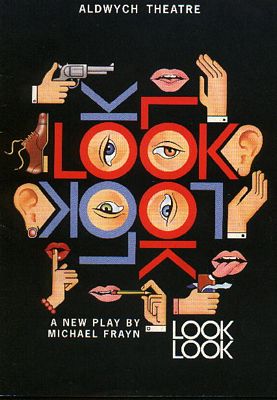
Cast
| F 13 Joan | Margaret Courtenay |
| F l4 Helena | Gabrielle Drake |
| F l2 Quentin | Robin Bailey |
| G 13 Lee | Steven Mackintosh |
| G 14 - later G 15 Wendy | Lisa Jacobs |
| G 15 - later F 15 Charles | Michael Simkins |
| G 15 - later G 14 Reginald | John Arthur |
| G 16 - later F 16 Amanda | Serena Gordon |
| G16 Eileen | Pat Keen |
| H 18 Keith | Stephen Fry |
| 116 Bobbie | Joyce Grant |
| 117 Merrill | Ken Wynne |
| Usherette | Jeanne Mockford |
| Stage Manager | Krissy Wilson |
| With | Maggie Ashe Maitland Chandler Sean Patterson Rowena Petty, Mark Phillips Helen Wassell, Nicholas Wolff |
Review
Most people have preconceived notions about the theatre, some love the glamour, some the freedom and some just an enjoyable evening out, whatever you may feel will undoubtedly be questioned in your own mind once you have seen Michael Frayn's new play Look Look.
An auditorium made up of rows of theatre seats is on the stage, a flimsy blue net curtain hangs in front. People begin to filter slowly onto the stage and shift through the respective rows to find their seats. The curtain rises, and 'we' the real audience are faced with a mirror image, this becomes slightly disconcerting for Frayn's 'audience' then proceeds to display a number of familiar 'audience idiosyncrasies' cleverly done through a series of coughing fits, petting, paper shuffling and paranoia. Amidst the crowd is the play’s author Stephen Fry who becomes increasingly perturbed as the audience seems unable to settle.
Margaret Courtenay and Gabrielle Drake are a starchy mother-daughter double-act who exchange pleasantries with Robin Bailey who plays an actor who is aware, but ashamed of the fact that he is partial to the company of young boys. Serena Gordon and Michael Simpkins play a couple both married - but not to each other. These, along with an invalid, an erratic family and a couple of bolshy teenagers spend much of the first act acknowledging, reassuring and irritating one another while finding the time to criticise the play they have come to see. Fry, the author, takes us through these events with wry commentary and we soon realise that Frayn is dealing with a three dimensional relationship about watching, being watched and being watched watching. It is at this point that you stop trying to rationalise and decide to accept the confusion.
Frayn's 'audience’ takes on the role of actors and position themselves on the other side of the blue net curtain and so begins the second act. A host of skittish scenes follow where personalities are fused into one. Robin Bailey is no longer the super-confident sophisticated theatre lover but a nervous badly prepared understudy and through some nonsensical sketches incorporating these distorted characters, all elements of romance, farce, pathos and suspense are ridiculed.
Margaret Courtenay, Stephen Fry and Robin Bailey, charismatic as ever, add the credibility to this play. Frayn forces you to look at the relationships of actors and audiences along with theatre and real life. Reaction is the key word. The question being is there a sting to this ‘tale' and, if so, is the joke on us?